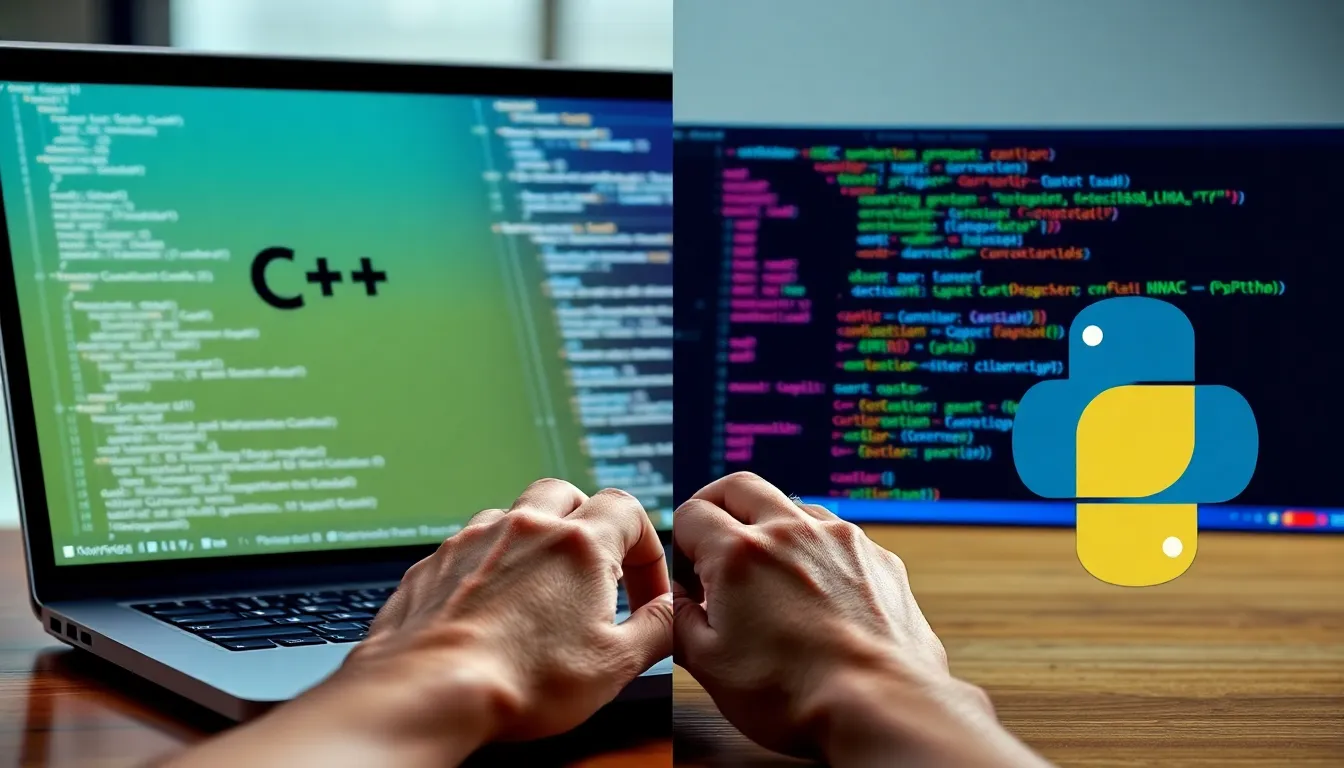In the world of programming, C++ and Python stand out as two of the most popular languages, each boasting unique strengths and applications. C++ offers powerful performance and control, making it a favorite for system-level programming, game development, and applications requiring high efficiency. On the other hand, Python’s simplicity and versatility have made it the go-to choice for web development, data analysis, and artificial intelligence.
As developers navigate the ever-evolving tech landscape, choosing the right language can significantly impact project outcomes. Understanding the key differences between C++ and Python helps in making an informed decision, whether it’s for a complex software system or a simple script. This article delves into the core aspects of both languages, highlighting their features, use cases, and the best scenarios for each.
Table of Contents
ToggleOverview of C++ and Python
C++ and Python serve different purposes in software development, each with unique advantages.
C++
C++ is a compiled language known for its performance and flexibility. It supports both object-oriented and procedural programming paradigms, allowing developers to choose the approach that fits their project. C++ provides extensive control over system resources, making it ideal for applications requiring high performance, such as game engines and real-time simulations. C++ also facilitates low-level memory manipulation, which enhances efficiency but introduces complexity.
Python
Python is an interpreted, high-level language designed for ease of use and readability. Its simple syntax promotes rapid development and makes it ideal for beginners. Python is versatile, serving numerous domains, including web development, data science, machine learning, and automation. Extensive libraries and frameworks, like Django for web development and Pandas for data manipulation, contribute to Python’s popularity. Its community support also ensures continuous growth and a wealth of resources for developers.
Comparison
| Feature | C++ | Python |
|---|---|---|
| Typing | Static | Dynamic |
| Speed | High performance | Slower due to interpretation |
| Syntax | Complex | Simple |
| Memory Management | Manual control | Automatic garbage collection |
| Use Cases | System programming, games | Web development, AI, data science |
C++ excels in performance-critical applications, whereas Python stands out in rapid prototyping and ease of integration with various technologies. Both languages play crucial roles in today’s software ecosystem, providing developers with various tools to address specific project needs.
Key Differences Between C++ and Python

C++ and Python differ significantly in various aspects, including syntax, readability, performance, and efficiency. Understanding these differences helps developers choose the appropriate language for their specific needs.
Syntax and Readability
C++ features a complex syntax that often requires more lines of code to perform similar tasks compared to Python. This complexity can make C++ challenging for beginners. In contrast, Python’s syntax is clear and concise, making it easier to learn and read. Python emphasizes the use of indentation to define code blocks, which helps maintain structure and readability. Developers often find that Python’s simplicity allows them to implement solutions quickly, reducing the time spent on debugging and maintenance.
Performance and Efficiency
C++ excels in performance and efficiency due to its compiled nature and static typing. Compiled languages convert code directly into machine language, resulting in faster execution. This capability makes C++ suitable for resource-intensive applications like gaming and system software. Python, an interpreted language, prioritizes ease of use over speed. Its dynamic typing and automatic memory management introduce overhead, leading to slower performance in comparison. While Python’s execution speed may lag, its extensive libraries and frameworks facilitate rapid development, proving advantageous for applications that don’t require maximum performance.
Use Cases for C++ and Python
C++ and Python serve various purposes across multiple domains. Their unique features cater to different programming needs, making them invaluable tools for developers.
Suitable Applications for C++
- Game Development: C++ dominates game engine development due to its high-performance capabilities and fine control over system resources. Engines like Unreal utilize C++ for real-time graphics processing.
- Embedded Systems: C++ operates efficiently in resource-constrained environments. Its close-to-hardware nature allows developers to create applications for microcontrollers and IoT devices.
- High-Performance Applications: C++ is suitable for applications requiring speed and efficiency, such as computational-heavy simulations and financial modeling systems.
- Operating Systems: Many operating systems, including Windows and Linux, leverage C++ for its performance and system-level access, ideal for managing hardware resources.
- Graphics and Real-Time Software: C++ excels in applications involving graphics rendering, such as CAD software and 3D modeling tools, owing to its ability to manage memory effectively and process data with high speed.
Suitable Applications for Python
- Web Development: Python’s frameworks, including Django and Flask, facilitate quick web application development, making it a popular choice for startups and established enterprises alike.
- Data Science and Machine Learning: Python integrates libraries like Pandas, NumPy, and TensorFlow, enabling efficient data analysis and machine learning model development.
- Scripting and Automation: Python is ideal for scripting repetitive tasks and automating workflows in various applications, improving productivity and streamlining processes.
- Artificial Intelligence: Python’s clear syntax and rich libraries support AI projects, making it the go-to language for implementing neural networks and natural language processing.
- Education and Research: Python’s simplicity and readability make it a favored choice in academic settings for teaching programming concepts and building prototypes.
Advantages and Disadvantages
Both C++ and Python possess distinct advantages and disadvantages, catering to different programming needs and environments. Understanding these can guide developers in selecting the right language for their projects.
Pros and Cons of C++
Advantages:
- High Performance: C++ delivers superior execution speed due to its compiled nature.
- Memory Control: C++ provides extensive control over system memory, allowing for optimized resource management.
- Object-Oriented Programming: C++ supports object-oriented features, enabling code reuse and modular programming.
- Rich Libraries: C++ has numerous libraries and frameworks, enhancing functionality across various applications.
- Portability: C++ code can run on multiple platforms with minimal changes, promoting flexibility.
Disadvantages:
- Complex Syntax: C++ features intricate syntax that can be challenging, especially for beginners.
- Manual Memory Management: Developers must manage memory manually, increasing the risk of memory leaks and bugs.
- Longer Development Time: C++ often requires more extensive coding for similar tasks compared to higher-level languages like Python.
- Steeper Learning Curve: New programmers may face more difficulties when learning C++ due to its complexities.
Pros and Cons of Python
Advantages:
- Ease of Use: Python’s simple and readable syntax makes it an excellent choice for beginners and rapid development.
- Dynamic Typing: Python allows for dynamic typing, which enhances flexibility and code simplicity.
- Extensive Libraries: Python boasts a vast array of libraries that facilitate tasks in web development, data science, and machine learning.
- Automatic Memory Management: Python manages memory automatically, simplifying programming tasks and reducing errors.
- Community Support: Python has a large active community, providing extensive resources for troubleshooting and learning.
- Slower Performance: Python’s interpreted nature can lead to slower execution times compared to compiled languages like C++.
- Limited Control: Python offers less control over hardware resources, which may hinder performance in resource-intensive applications.
- Threading Limitations: Python’s Global Interpreter Lock (GIL) can restrict multi-threading and limit performance on multi-core systems.
- Dependency Management: Managing library dependencies can become cumbersome, especially in complex projects.
Choosing between C++ and Python ultimately depends on the specific requirements of a project. C++ offers unmatched performance and control for applications where speed and resource management are critical. Its complexity might challenge beginners but rewards those who master it with powerful capabilities.
On the other hand, Python shines in scenarios where rapid development and ease of use are paramount. Its simplicity and extensive libraries make it a go-to language for data science and web development. Each language has its strengths and weaknesses, making them essential tools for developers. Understanding these differences enables informed decisions, ensuring the right language is selected for the right task.

